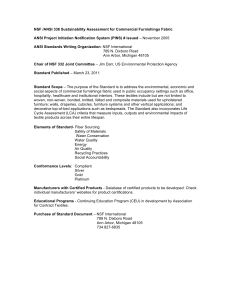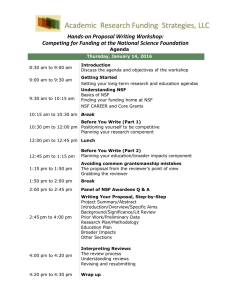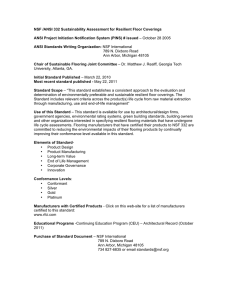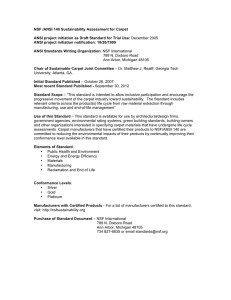NSF/ANSI Standard 350 for water reuse
advertisement
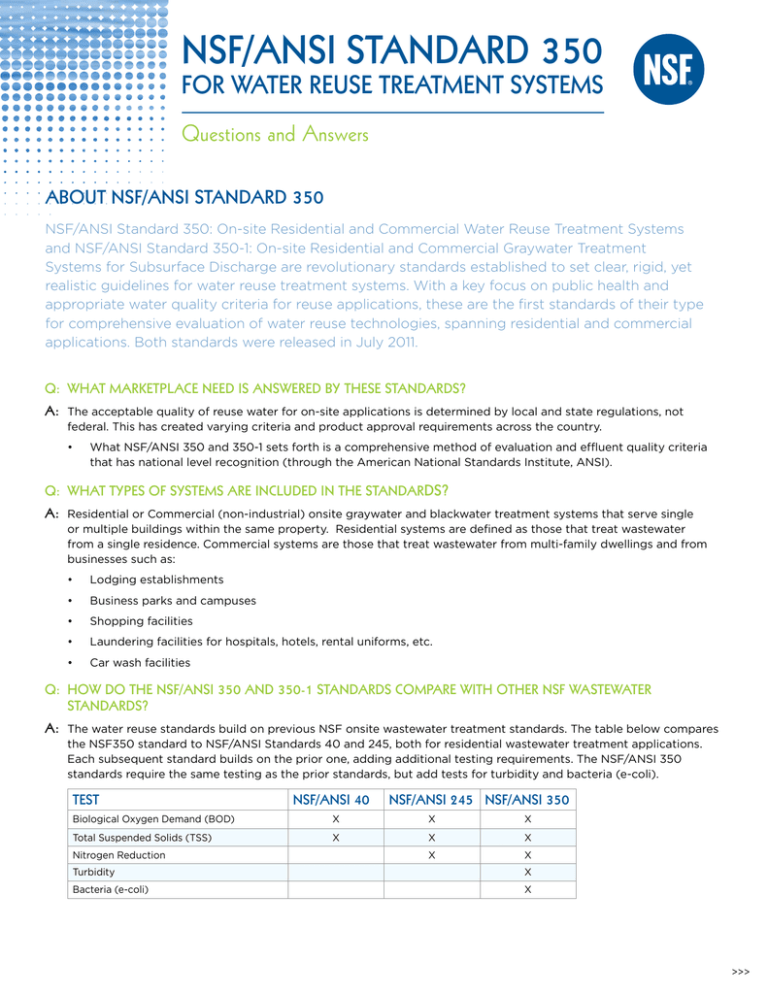
NSF/ANSI Standard 350 for water reuse treatment systems Questions and Answers about nsf/ansi standard 350 NSF/ANSI Standard 350: On-site Residential and Commercial Water Reuse Treatment Systems and NSF/ANSI Standard 350-1: On-site Residential and Commercial Graywater Treatment Systems for Subsurface Discharge are revolutionary standards established to set clear, rigid, yet realistic guidelines for water reuse treatment systems. With a key focus on public health and appropriate water quality criteria for reuse applications, these are the first standards of their type for comprehensive evaluation of water reuse technologies, spanning residential and commercial applications. Both standards were released in July 2011. Q:What marketplace need is answered by these standards? A: The acceptable quality of reuse water for on-site applications is determined by local and state regulations, not federal. This has created varying criteria and product approval requirements across the country. • What NSF/ANSI 350 and 350-1 sets forth is a comprehensive method of evaluation and effluent quality criteria that has national level recognition (through the American National Standards Institute, ANSI). Q:What types of systems are included in the standards? A: Residential or Commercial (non-industrial) onsite graywater and blackwater treatment systems that serve single or multiple buildings within the same property. Residential systems are defined as those that treat wastewater from a single residence. Commercial systems are those that treat wastewater from multi-family dwellings and from businesses such as: • Lodging establishments • Business parks and campuses • Shopping facilities • Laundering facilities for hospitals, hotels, rental uniforms, etc. • Car wash facilities Q:How do the NSF/ANSI 350 and 350-1 standards compare with other NSF wastewater standards? A: The water reuse standards build on previous NSF onsite wastewater treatment standards. The table below compares the NSF350 standard to NSF/ANSI Standards 40 and 245, both for residential wastewater treatment applications. Each subsequent standard builds on the prior one, adding additional testing requirements. The NSF/ANSI 350 standards require the same testing as the prior standards, but add tests for turbidity and bacteria (e-coli). Test NSF/ANSI 40 NSF/ANSI 245 NSF/ANSI 350 Biological Oxygen Demand (BOD) X X X Total Suspended Solids (TSS) X X X Nitrogen Reduction X X Turbidity X Bacteria (e-coli) X >>> Q:What types of water can be treated in systems covered by these standards? A: Systems that treat all wastewater generated onsite including blackwater (toilet, kitchen or other high organic sources) and graywater (laundry, bathing) OR Systems that treat only graywater. Within this graywater portion, systems can be evaluated for specific wastewater streams such as only bathing water or only laundry water, etc. (See Table 1 below) Table 1: Scope of Standards Standard 350: On-site Residential and Commercial Water Reuse Treatment Systems Building Types Residential, up to 1,500 gallons per day Commercial, more than 1,500 gallons per day and all capacities of commercial laundry water Types of wastewater treated (influent) Combined black and graywater Graywater Bathing water only Laundry water only Uses of treated water (effluent) Nonpotable applications, such as surface and subsurface irrigation and toilet and urinal flushing Ratings Two classifications that vary slightly in treated water quality: Class R: single-family residential Class C: multifamily and commercial Systems are further described by the type of wastewater treated (combined, graywater, bathing only or laundry only). NSF/ANSI Standard 350-1: On-site Residential and Commercial Graywater Treatment Systems for Subsurface Discharge Building Types Residential, capacities up to 1,500 gallons per day Commercial, capacities more than 1,500 gallons per day and all capacities of commercial laundry water Types of wastewater treated (influent) Combined black and graywater Graywater Bathing water only Laundry water only Uses of treated water (effluent) Subsurface irrigation only Ratings Single effluent quality with no classifications Systems are further described based on the type of influent (graywater, bathing only, laundry only). Q:Where can onsite treated water be reused? A: Treated water meeting the requirements of NSF/ANSI 350 can be used for toilet and urinal flushing, irrigation, decorative fountains, car washing and other non-potable water applications. Q:What is the certification process for these standards? A: NSF verifies that all design and performance requirements of the standards have been met, and confirms through testing that effluent reuse water meets stringent quality criteria for designated uses. • Both NSF Standards 350 and 350-1 require 26 weeks of continuous testing with regularly scheduled sampling throughout, typically 3 days a week. This lengthy testing time with high sampling volume is designed to assess the reliability of the treatment system product over time. • A further requirement prohibits routine service and maintenance of the system during the test period. This rigorous test protocol favors reliable systems designed for reduced frequency of service and maintenance. • In addition to performance testing, compliance with design specifications and literature is reviewed. For instance, the control panel is evaluated and all alarm systems tested. • Annual audits of manufacturing facilities are required and all changes to the design must be reviewed and evaluated to determine if retesting is required. After 7 years, a re-evaluation is done and could require a partial or full re-testing if significant changes in the design of the system have occurred. • The 350 and 350-1 standards allow full testing of one product in a series and if all other designs are just proportionately larger, approval can be given for all by design review of the engineering documents. >>> Q:What are the benefits to manufacturers of onsite wastewater treatment systems having NSF certification? A: Manufacturers gain: • Independent validation of system performance by a respected third-party organization, well known in the public health, drinking water, plumbing and wastewater arenas. • Proof of a manufacturer’s voluntary effort to demonstrate the performance and reliability of their technology, including detailed, comprehensive test reports for distribution to customers, specifiers and public health officials. • Public listing in the NSF web-based directory of certified treatment systems. • Use of the respected NSF Certification Mark on all certified systems and related promotional materials. Q:What are the benefits to public health officials of onsite wastewater treatment systems having NSF certification? A: • Physical audit of manufacturing facility to ensure product meets proper specifications. • Required review and approval of all product modifications. • Periodic reevaluation of certified product to ensure continued compliance with the standard and certified claims. • Investigation of complaints, and enforcement actions for non-compliance. Q:What groups were involved in developing the NSF/ANSI 350 Standard? A: This is an American National Standard which had participation from U.S. and international groups including manufacturers of treatment technology (Australia and US), plumbing fixture in developing the standard including manufacturers, plumbing code bodies, public health officials (EPA, state and local), and advocacy groups including the Alliance for Water Efficiency, National Resources Defense Council (NRDC) and others. Q:What green building rating systems currently recognize water reuse strategies that could be achieved by products certified to the NSF/ANSI 350 standard? A: LEED for Homes (2008) projects can earn up to one point in Water Efficiency Credit 1.2 Graywater Re-use System by installing a graywater reuse system for landscape irrigation or indoor water use. (LEED for Homes Rating System, January 2008, page 46). LEED Building Design and Construction (BD+C) 2012 (Draft July 2011) Water Efficiency Credit: Sustainable Wastewater Management, under OPTION 2: Reuse, a project can earn up to 2 points for implementing water re-use. This credit specifically mentions the NSF/ANSI 350 standard and requires “Reused water must meet the applicable NSF 350 standard or local code, whichever is more stringent” (excerpted from LEED BD+C, LEED Rating System 2nd Public Comment draft, July 2011, page 74). National Association of Home Builders, through its National Green Building Certification program, includes graywater in Innovative Practices 802.1. Points may be awarded/earned for graywater reuse strategies such as water closets flushed by reclaimed or recycled water or irrigation from reclaimed or recycled water onsite. Q:What regulatory drivers are there for the NSF/ANSI 350 Standard? A: The NSF/ANSI 350 standard is gaining momentum on the regulatory front: • Washington State adopted it in their standards. • The International Association of Plumbing and Mechanical Officials (IAPMO) and International Code Council (ICC) have already included the standard in their draft plumbing codes. • Australia, European countries and Canada have all expressed interest in the standard. Canada will reference the NSF/ANSI 350 standard rather than creating a duplicate standard. Q: Where can I LEARN more about NSF/ANSI Standard 350 for Water Reuse treatment technologies? A: Call NSF at +1.734.769.5575 or email nsf350@nsf.org for more information. NSF International 789 N. Dixboro Road • Ann Arbor, MI 48105 1-800-NSF-MARK or 734-769-8010 p • 734-769-0109 f www.nsf.org • info@nsf.org LWW-1116-0911
